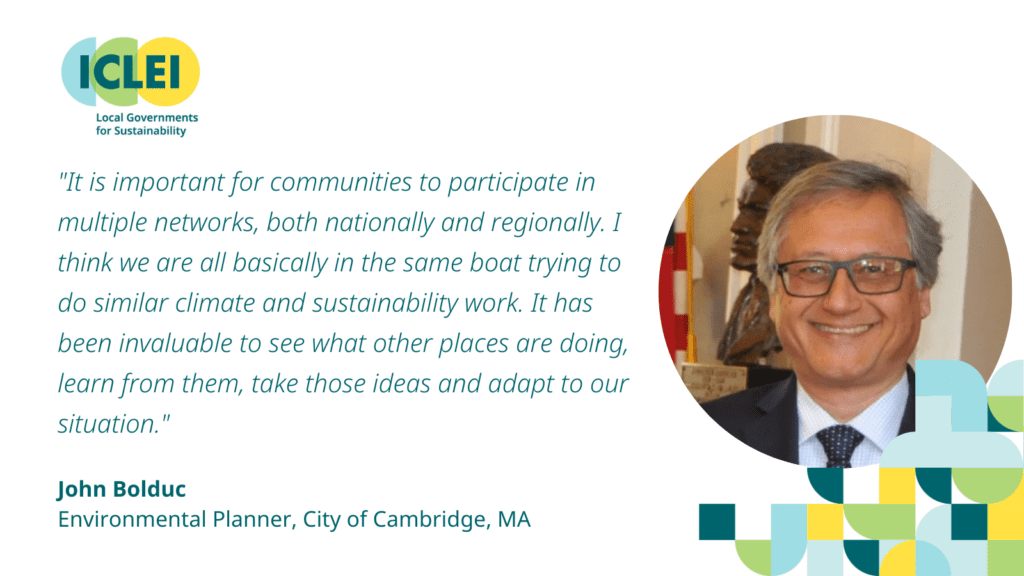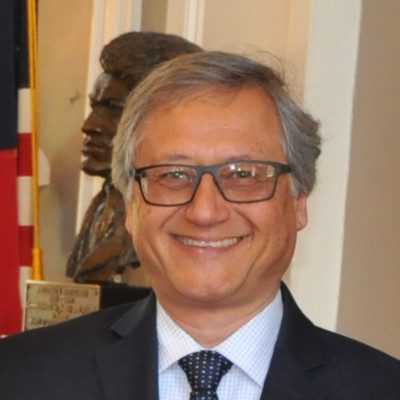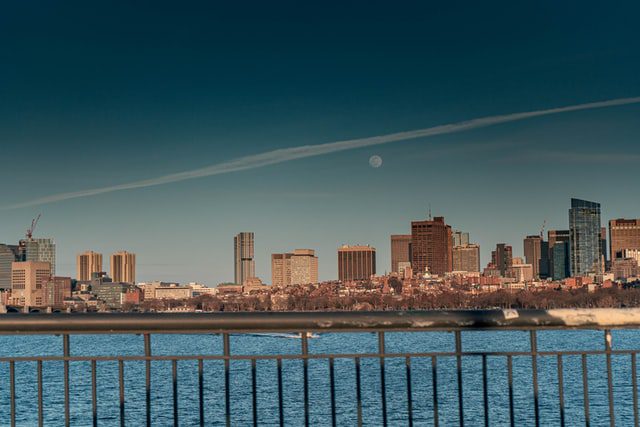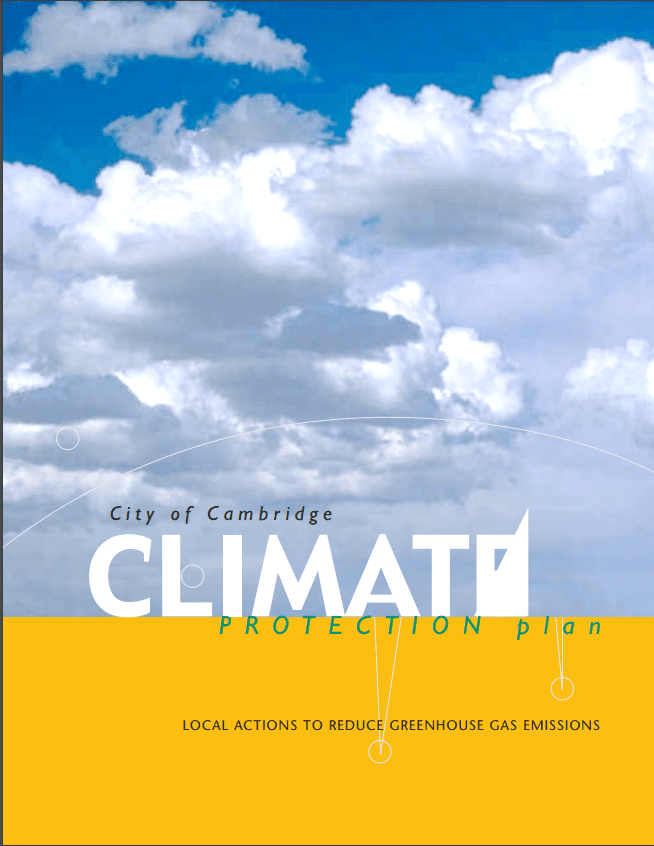With over 24 years of experience in sustainability planning at the City of Cambridge, John Bolduc is truly an ICLEI Network Champion and an impactful sustainability leader. Bolduc has worked at the City’s Community Development Department since 1997, primarily focusing on planning and managing initiatives on climate change mitigation and adaptation. Read insights from an ICLEI Network Champion about his background, the evolution of local sustainability and future trends, career highlights, and lessons learned.
Pioneering Early Local Climate Efforts
Passionate about the environmental field and being in public service, Bolduc pursued a B.S. in Resource Economics at the University of California, Davis, and a M.A. in Urban & Environmental Policy at Tufts University. While building his foundational knowledge and experience with urban and environmental policy, Bolduc was drawn to state and local work to be closer to a community’s issues.
When Bolduc began his career in local sustainability and environmental work, there weren’t many jobs focused on his areas of interest, let alone ones that included climate change in job descriptions. So Bolduc began his career in conservation and environmental planning by working in local governments across Massachusetts for 12 years, specifically Wellesley, Marlborough, and Brookline.
When Bolduc started at the City of Cambridge in 1997, he was interested in cities’ critical role in overall sustainability. By improving the sustainability of a city, then a community could reduce its environmental footprint. Early in his career, Bolduc’s work focused on addressing brownfields and toxic pollutants and reviewing development projects for environmental impact.
Within two years of working at the City, Cambridge was recruited by ICLEI USA’s Cities for Climate Protection program (a leadership-and-learning technical program accompanied by a tool that was the precursor to ICLEI’s ClearPath climate planning software). Intrigued by sustainability through the lens of greenhouse gas emissions, the City of Cambridge joined the ICLEI network to learn about sustainable development and use sustainability frameworks.
When asked about the benefits of being part of a local government network, Bolduc shared, “It is important for communities to participate in multiple networks, both nationally and regionally. I think we are all basically in the same boat trying to do similar climate and sustainability work. It has been invaluable to see what other places are doing, learn from them, take those ideas and adapt to our situation, and hopefully give something back.”
Through the partnership with ICLEI USA, the City created a greenhouse gas inventory and found one of the largest sources of emissions was from building energy use, particularly among businesses, institutions, and government. With concrete data on hand, the City made its first Climate Action Plan in 2002 with a citizens task force. The Cambridge Climate Action Plan became a symbol for the community and the City, where sustainability was an all-hands-on-deck effort.
Evolution of Local Sustainability and Future Trends
At the beginning of Bolduc’s career, recycling was a common trend with sustainability initiatives at local governments. Recycling was often the first step a community would take to reduce waste. Next, communities would reduce traffic congestion with improved transportation and increase sustainable transportation options. For Cambridge, the next sustainability initiative was addressing building emissions.
Over his 25 years of service at the City of Cambridge, Bolduc saw sustainability efforts evolve in numerous areas:
- Climate and sustainability plans shifted from solely focusing on preventing climate change to including adaptation initiatives, such as vulnerability assessments.
- Municipalities made climate and sustainability plans to outline their efforts to lead by example, but now these plans integrate and engage the community (e.g., universities, residents, and businesses).
- Municipalities developed Climate Advisory Committees to increase transparency and accountability. The City of Cambridge established its standing climate advisory committee, called the Climate Protection Action Committee, in 2003.
- Climate and sustainability approaches were voluntary but now are mandatory through ordinances and legal requirements.
- The emergence of building performance benchmarking and science-based targets to track and achieve goals.
In the next 5 to 10 years, Bolduc sees the sustainability field focusing on advancing current topics, such as street flooding, urban forest canopy, reflective surfaces, and heat resilience. Bolduc emphasized the importance of bolstering standards, especially for benchmarking existing buildings.
Career Highlights
With over 25 years at the City of Cambridge, Bolduc has supported and led many climate change mitigation and adaptation initiatives. During this time at the City, four highlights stand out:
- The City of Cambridge’s Climate Action Plan engages other city departments and community stakeholders with reducing emissions across the entire city to reach carbon neutrality by 2050.
- The Building Energy Use Disclosure Ordinance covers about 1,100 buildings out of 14,000 in Cambridge that account for most energy use and emissions.
- The Resilient Cambridge Plan outlines pathways for the community to reduce the risks from climate change and prepare the community for impacts.
- Urban Forest Master Plan provides a roadmap to evaluate, maintain, and expand the urban forest canopy in light of climate change adaptation.

“Our Resilient Cambridge Plan, which is the culmination of eight years of work, is a very rigorous climate adaptation plan. The process of developing the plan was very useful for us to understand what climate change means to Cambridge,” he explained, “Various city departments collaborated on the plan, which had the effect of advancing issues within the community.”
Lessons Learned: Challenges and Advice
Throughout the field of local sustainability, there are many challenges municipalities and staff must overcome. One of the biggest challenges in sustainability is the urgency of climate change action and increasing public awareness and community engagement.
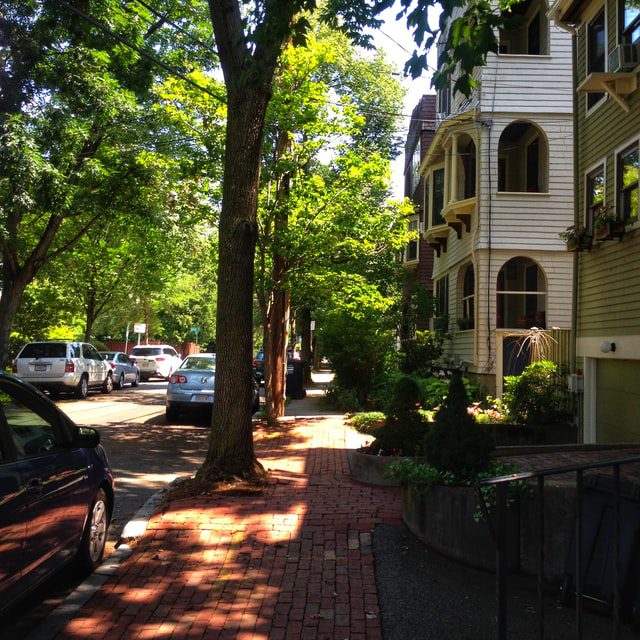
Regarding public engagement and outreach, Bolduc said, “There’s still the challenge to engage people, to address urgent problems, in the end for people to realize you have to take action now to avoid the big problems down the road. To address this, I suggest engaging the community and developing approaches, basically co-create with community stakeholders, so the public understands the need to take action.”
Another challenge is communicating with stakeholders about the connection between a city and its environmental system. For example, Bolduc shares how urban development contributes to creating urban heat islands and why zoning impacts this. He suggests using modeling and mapping to visualize the systems and their interactions as one way to bridge the communication gap.
Additionally, there is a significant concern about equity and climate change. Municipalities need to recognize and address how underserved communities will be disproportionately affected by climate change impacts, such as energy costs. Bolduc emphasizes that communities must consider the unequal distribution problems within policy-making and address these inequities, but the first step is to recognize these problems.
Network Champion: John Bolduc
After decades of climate action and dedication, it is safe to say that Bolduc has made his mark in local sustainability. In his next chapter, Bolduc hopes to continue his work within the world of sustainability and climate change. ICLEI USA is honored to work with ambitious climate leaders like John Bolduc and thanks him for his service and dedication.
